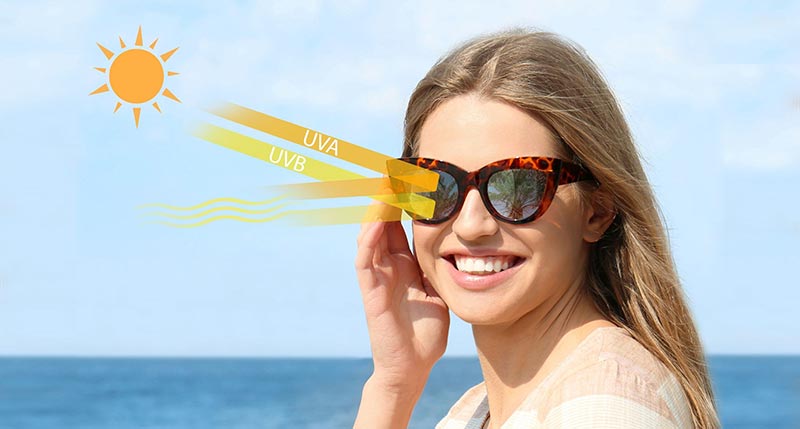June, July, and August are when the sun’s rays are most intense in the US. That’s why June 27 is National Sunglasses Day, reminding us about the importance of protecting your eyes from the sun’s ultraviolet (UV) rays by wearing sunglasses every day, every time we go outside.
June is also Cataract Awareness Month. It’s no coincidence that National Sunglasses Day comes during Cataract Awareness Month: Sun exposure increases the likelihood for individuals to develop cataracts. While we can’t say for sure that the sun causes cataracts, we know UV exposure over a lifetime contributes to the development of cataracts.
The World Health Organization (WHO) blames the sun’s UV rays for two significant public health challenges: skin cancer and cataracts. With the ozone layer thinner now than it was 30 years ago, the sun’s UV rays reach Earth’s surface at a much higher rate than they did when the ozone layer was healthier. (Good news on that front: Earth’s ozone layer is on track to recover to its 1980s-era status within about 40 years.)
What are Cataracts?
Cataracts are a clouding of the eye’s lens that can cause blurry vision, color vision changes, poor night vision, and sensitivity to light. One reason that older people tend to suffer from cataracts is that damage caused by the sun’s UV rays to the eyes is cumulative over a lifetime of unprotected sun exposure. (So, wear your sunglasses!)
Cataracts are the No. 1 cause of vision loss in the US and the No. 1 cause of blindness worldwide. The WHO estimates that UV exposure may cause more than 2 million people to go blind worldwide each year. In the US, UV exposure contributes to the fact that more than half of people experience cataracts by age 80.
What are the Eye Dangers of UV Rays?
Whether you apply sunscreen each day or usually skip it, at some point the sun’s rays find unprotected skin and —Ouch! — sunburn can really hurt.
Your eyes can get sunburned, too. If you spend hours in the sun without wearing high-quality sunglasses, your eyes may become red, swollen, painful, blurry, and you may even experience temporary blindness!
Here’s why: UV rays are a form of electromagnetic radiation produced by the sun. There are three UV categories: UVA, UVB, and UVC. UVA rays are the most common and have the longest wavelength; UVB rays have a shorter wavelength and are more intense. UVC rays have the shortest wavelength, making them the most dangerous to skin and eyes, but fortunately, UVC rays are mostly absorbed by the Earth’s ozone layer and do not reach us. (Thank you, ozone layer!)
UVA and UVB ray exposure is linked to a variety of eye problems, which include cataracts, macular degeneration, and cancer of the eyelid.
3 Ways to Protect Eyes From UV Damage
So, how do you protect your eyes from the sun’s harmful rays? Here are 3 ways:
- Wear High-Quality Sunglasses Daily
The most effective protection is to wear sunglasses that provide you with 100% UV protection. Not all sunglasses provide this level of protection, so it’s important to verify that yours offer “100% UV protection” and to purchase your sunglasses from a reputable source. Additionally, a wide-brimmed hat can also help to shield your eyes from the sun.
- Avoid the Sun at Mid-Day
Another way to protect your eyes from UV rays is to be aware that the sun’s rays are strongest between 10 a.m. and 4 p.m. — and avoid those strong rays. Either time your activities to avoid being outside during these hours, spend more time in the shade, or take extra precautions by wearing sunglasses and a hat.
- Beware of Reflected UV Rays
It’s not just the sun’s rays from above that you must avoid — it’s also the UV rays reflected off of surfaces and shining into your eyes. Snow, water, sand, metal, sidewalks, and buildings reflect high levels of UV rays. Sunglasses protect from reflected UV, so wearing them is your best defense.
Help Kids Develop the Sunglass Habit
You wouldn’t let your child spend hours in the sun without sunscreen, would you? Use that same protective instinct when it comes to sunglasses! Get your child a quality pair of sunglasses and help them develop good sunglasses habits!
Kids get more sun exposure than adults each year. In addition, children’s eyes aren’t fully mature, so UV rays cause even more damage to their developing eyes. One smart way to encourage your children to get into the good habit of wearing sunglasses is to wear your own sunglasses every day. Kids will copy your behaviors — both good and bad. So, help your kids develop the healthy habit of wearing sunglasses! It’s much easier than getting them to eat their veggies.
UV ray exposure can cause a variety of eye problems, but you can control how much UV your eyes absorb by wearing high-quality sunglasses with 100% UV protection. Your eyes and vision are a precious and irreplaceable gift; protect that gift every day by wearing sunglasses!
If you’re unsure whether your sunglasses provide 100% UV protection or if your sunglasses are scratched (which can decrease their UV protection), come in and see us. We have new sunglass styles arriving weekly, and our talented team will help you choose a pair that fits your face, your budget, and your lifestyle!


Recent Comments